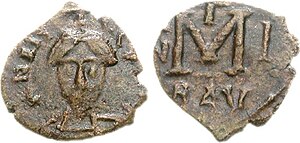The 740s decade ran from January 1, 740, to December 31, 749.

Year 748 (DCCXLVIII) was a leap year starting on Monday of the Julian calendar. The denomination 748 for this year has been used since the early medieval period, when the Anno Domini calendar era became the prevalent method in Europe for naming years.

Year 750 (DCCL) was a common year starting on Thursday of the Julian calendar, the 750th year of the Common Era (CE) and Anno Domini (AD) designations, the 750th year of the 1st millennium, the 50th year of the 8th century, and the 1st year of the 750s decade. The denomination 750 for this year has been used since the early medieval period, when the Anno Domini calendar era became the prevalent method in Europe for naming years. According to historian Peter Brown, this year marked the universal beginning of the Middle Ages across every human civilization, thus marking the end of the late antiquity along with the classical world.

Year 701 (DCCI) was a common year starting on Saturday of the Julian calendar, the 701st year of the Common Era (CE) and Anno Domini (AD) designations, the 701st year of the 1st millennium, the 1st year of the 8th century, and the 2nd year of the 700s decade. The denomination 701 for this year has been used since the early medieval period, when the Anno Domini calendar era became the prevalent method in Europe for naming years.

Abu al-ʿAbbās Abd Allāh ibn Muḥammad ibn ʿAlī ibn ʿAbd Allāh ibn ʿal-ʿAbbās, known by his laqab al-Saffah, was the first caliph of the Abbasid Caliphate, one of the longest and most important caliphates in Islamic history.

Kufa, also spelled Kufah, is a city in Iraq, about 170 kilometres (110 mi) south of Baghdad, and 10 kilometres (6.2 mi) northeast of Najaf. It is located on the banks of the Euphrates River. The estimated population in 2003 was 110,000. Currently, Kufa and Najaf are joined into a single urban area that is mostly commonly known to the outside world as 'Najaf'.
Qahtaba ibn Shabib al-Ta'i was a follower of the Abbasids from Khurasan who played a leading role in the Abbasid Revolution against the Umayyad Caliphate.

The Abbasid revolution, also called the Movement of the Men of the Black Raiment, was the overthrow of the Umayyad caliphate, the second of the four major caliphates in Islamic history, by the third, the Abbasid caliphate.

The Third Fitna, was a series of civil wars and uprisings against the Umayyad Caliphate. It began with a revolt against Caliph al-Walid II in 744, and lasted until 747, when Marwan II emerged as the victor. The war exacerbated internal tensions, especially the Qays–Yaman rivalry, and the temporary collapse of Umayyad authority opened the way for Kharijite and other anti-Umayyad revolts. The last and most successful of these was the Abbasid Revolution, which began in Khurasan in 747, and ended with the overthrow of the Umayyad Caliphate and the establishment of the Abbasid Caliphate in 750.
Khazim ibn Khuzayma al-Tamimi was a Khurasani Arab military leader. One of the early supporters of the Abbasid da'wa in Khurasan, he played a major role in the Abbasid Revolution against the Umayyads, and then spent the next two decades suppressing revolts across the Caliphate. As one of the main figures of the Khurasaniyya, the main power base of the Abbasid regime, he cemented his family in a position of power and influence: his sons would play an important role in the affairs of the Caliphate over the next decades.
Al-Hasan ibn Qahtaba ibn Shabib al-Ta'i was a senior military leader in the early Abbasid Caliphate.
Humayd ibn Qahtaba ibn Shabib al-Ta'i was a senior military leader in the early Abbasid Caliphate.
Yazid ibn Umar ibn Hubayra al-Fazari was the last Umayyad governor of Iraq. A son of former governor Umar ibn Hubayra, he became one of the most important partisans of Caliph Marwan II in the Third Fitna, but failed to stem the onslaught of the Abbasid Revolution. Defeated, he was captured and executed by the Abbasids after the Siege of Wasit.
The siege of Wasit involved the army of the Abbasid Revolution under al-Hasan ibn Qahtaba and the future Caliph al-Mansur, and the Umayyad garrison of Wasit under the last Umayyad governor of Iraq, Yazid ibn Umar ibn Hubayra. Yazid had been forced to abandon Kufa due to a rebellion by Abbasid sympathizers, and fled to Wasit, where he was besieged for 11 months, from August/September 749 to his surrender in June/July 750. The siege was marked by constant sallies and attacks, but as it progressed, the Umayyad garrison's morale collapsed and the internal divisions among the Qays and Yaman tribes began to manifest themselves. After news of the defeat of the Umayyad Caliph Marwan II at the Battle of the Zab and the Abbasid conquest of Syria arrived at Wasit, defections began. Yazid nevertheless held out for a few more months, until he received a pardon for himself and his followers from the Abbasid Caliph al-Saffah. Nevertheless, Yazid and his senior officers were executed soon after on al-Saffah's orders.
Abū ʿAwn ʿAbd al-Malik ibn Yazīd al-Khurasānī was an early supporter of the Abbasids. He participated in the campaigns of the Abbasid Revolution and served as governor of Egypt and Khurasan.
Ḥawthara ibn Suhayl al-Bāhilī was a Bedouin Arab administrator and military leader in the final years of the Umayyad Caliphate. The philosopher al-Kindī describes him as famous for his eloquence.
Abu Salama Hafs ibn Sulayman al-Khallal was an anti-Umayyad missionary and one of the principal leaders of the Hashimiyya movement, that launched the Abbasid Revolution. During September–November 749 he was the de facto ruler of Kufa and of the movement, and tried to install an Alid as caliph at the head of the Revolution. His efforts failed, and the Khurasani army instead recognized the Abbasid al-Saffah as caliph. He remained in office, but was assassinated by the Abbasids shortly after due to his pro-Alid leanings.
Abu Ishaq Ibrahim ibn Muḥammad ibn ʿAlī ibn ʿAbd Allāh ibn al-ʿAbbās (701/2 CE–749), better known as Ibrahim al-Imam, was the leader of the Abbasid family and of the clandestine Hashimiyya movement that prepared and launched the Abbasid Revolution against the Umayyad Caliphate.
Shabib is a male name. Notable people with the name include:







